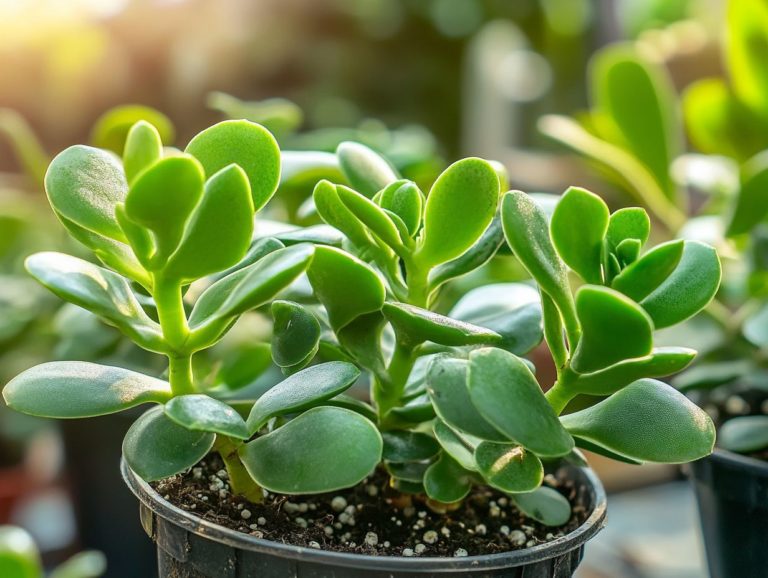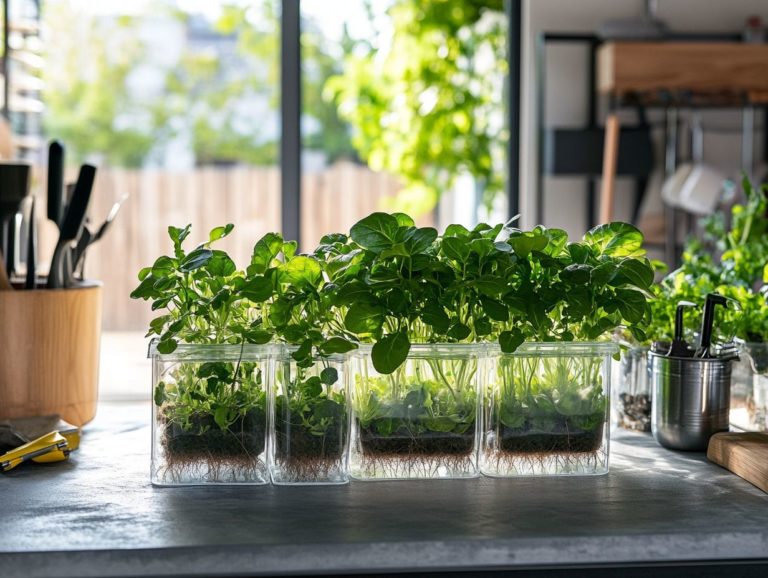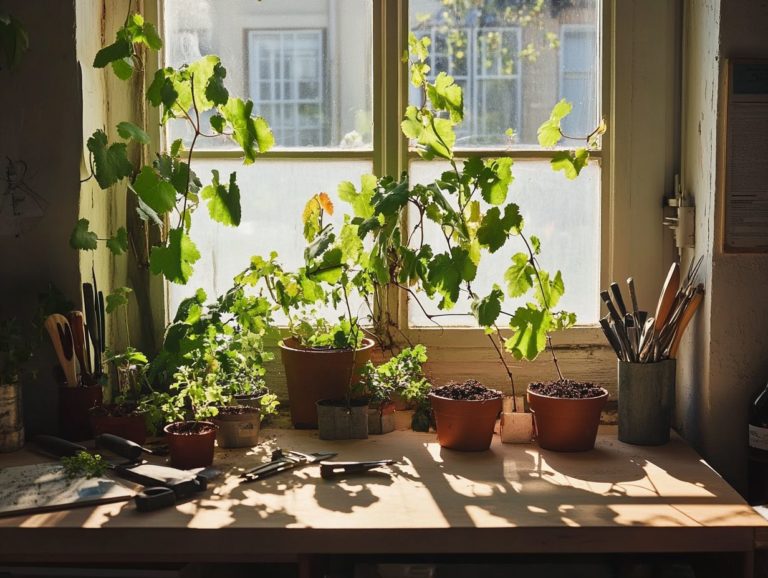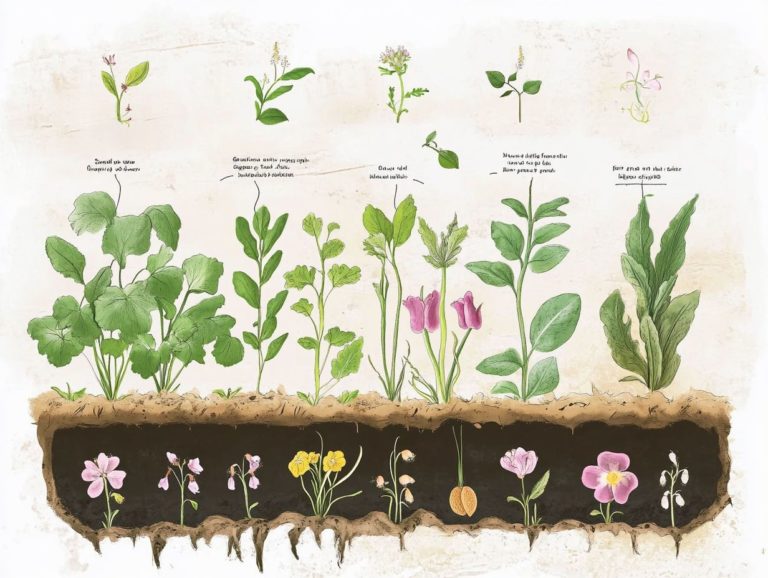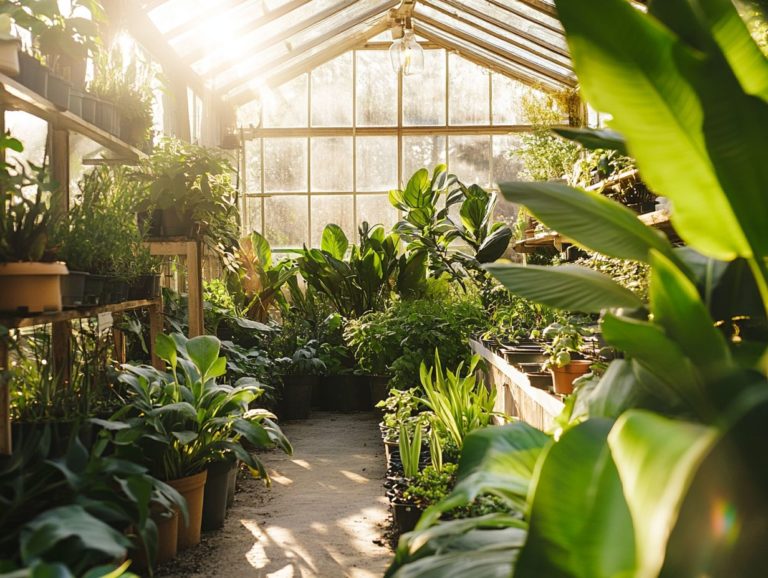How to Successfully Propagate Begonias
Begonias are cherished for their breathtaking foliage and vibrant blooms, making them a favorite among plant enthusiasts like yourself. Get ready to elevate your plant game with beautiful begonias!
Whether you’re aiming to expand your collection or share these exquisite plants with friends, learning how to propagate plants is essential.
This guide offers a comprehensive overview of everything you need to know from selecting the ideal time and methods for propagation to employing effective techniques like leaf and stem cuttings.
You’ll also find crucial care tips and troubleshooting advice to ensure your begonias flourish.
Prepare to nurture your green thumb!
Contents
Key Takeaways:
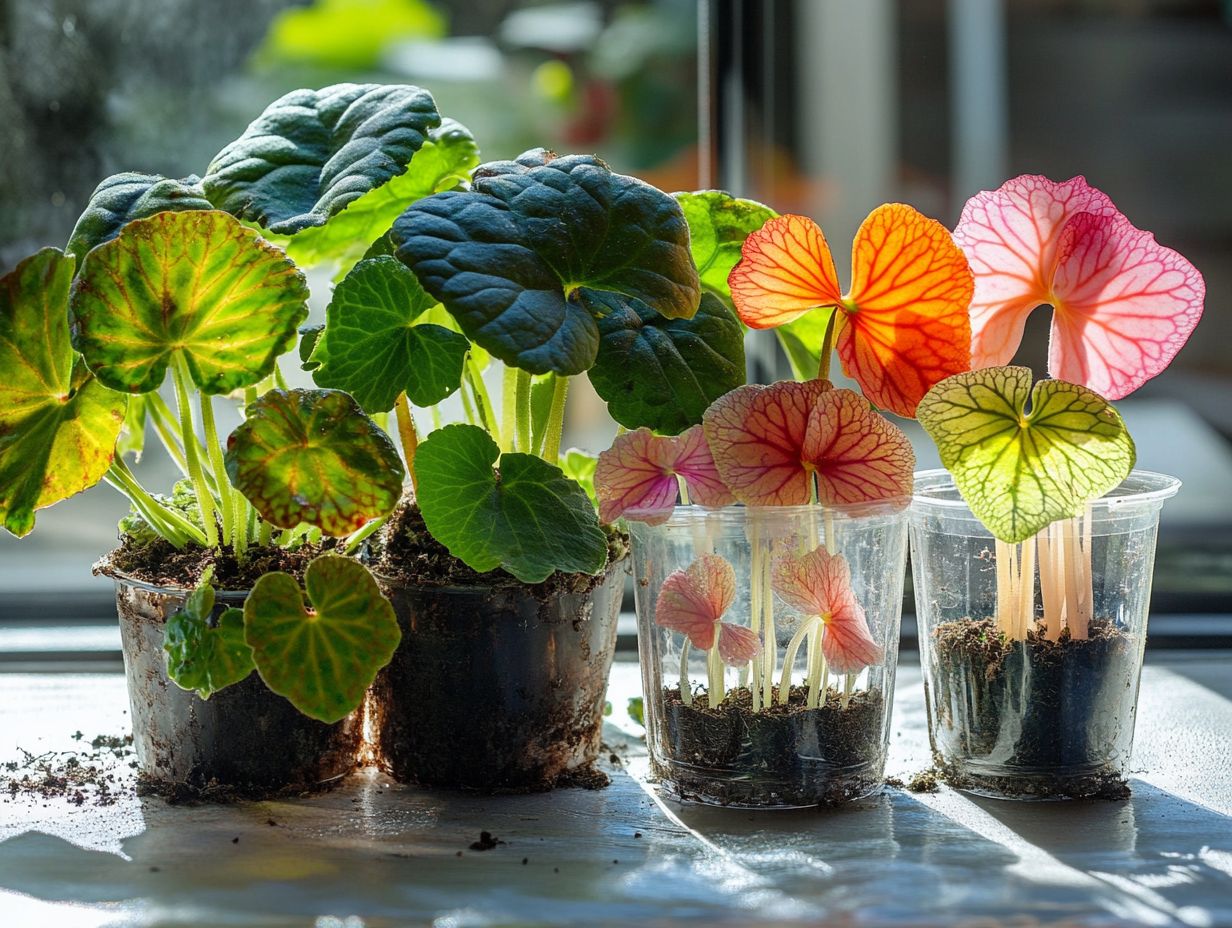
- Choose the right time and method for propagating begonias to ensure successful growth.
- Utilize various propagation techniques such as leaf cuttings, stem cuttings, and division to increase your chances of success.
- Transplant and maintain propagated begonias properly, and be aware of common issues and how to troubleshoot them for optimal plant health.
Overview of Begonias and Their Varieties
Begonias are a captivating collection of flowering plants celebrated for their striking leaves and exquisite blooms.
They thrive in various environmental conditions, making them a favored choice for gardening enthusiasts. With over 1,800 species and many hybrids, you can explore different forms such as rhizomatous, tuberous, and fibrous-rooted types. Each one requires specific care and propagation techniques to ensure healthy growth.
Take rhizomatous begonias, for example. Their stunning foliage, adorned with intricate patterns and vibrant hues, primarily comes from tropical regions of South America.
On the other hand, tuberous varieties steal the show with their impressive, oversized flowers, boasting colors that range from fiery reds to soft pinks, often gracing garden beds during the summer months.
To help these plants thrive, you’ll want to provide well-draining soil, moderate humidity, and indirect sunlight, allowing their lush colors to truly shine.
The unique characteristics of these various begonias are what make them so popular in home gardening. They effortlessly add a touch of elegance and charm to both indoor spaces and outdoor landscapes, inviting you to enjoy their beauty all year round.
Preparing for Propagation
To ensure the successful propagation of begonias, it is essential for you to grasp the key gardening tips and environmental conditions that promote healthy growth and sustainability in your new plants. Thoughtful planning will guarantee that your propagation efforts result in vibrant, disease-free clones that flourish beautifully, whether indoors or outdoors. Don t wait! Start your propagation journey now to enjoy flourishing begonias in no time!
Choosing the Right Time and Methods
Choosing the right time and methods for propagating begonias is crucial for ensuring your plants thrive with robust growth and vitality. Typically, the optimal timing aligns with their flowering season, when they re most active and ready to flourish.
By understanding various propagation methods such as stem cuttings, leaf cuttings, and tuber cuttings you ll be well-equipped to clone your favorite begonia species successfully. Each method has its unique strengths and requires specific care for the best results.
For instance, stem cuttings, taken during late spring or early summer, thrive in warm, humid conditions and do particularly well with a bit of rooting hormone a substance that helps cuttings develop roots to encourage growth.
Leaf cuttings are most effective in early spring, needing indirect light to prevent scorching and a well-draining mix to avoid rot. Tuber propagation should be done in late winter, where proper storage and careful handling can yield healthy sprouts come spring.
No matter which method you decide to use, providing consistent moisture, avoiding direct sunlight, and keeping your tools clean are essential for the success of your propagation efforts.
Propagation Techniques
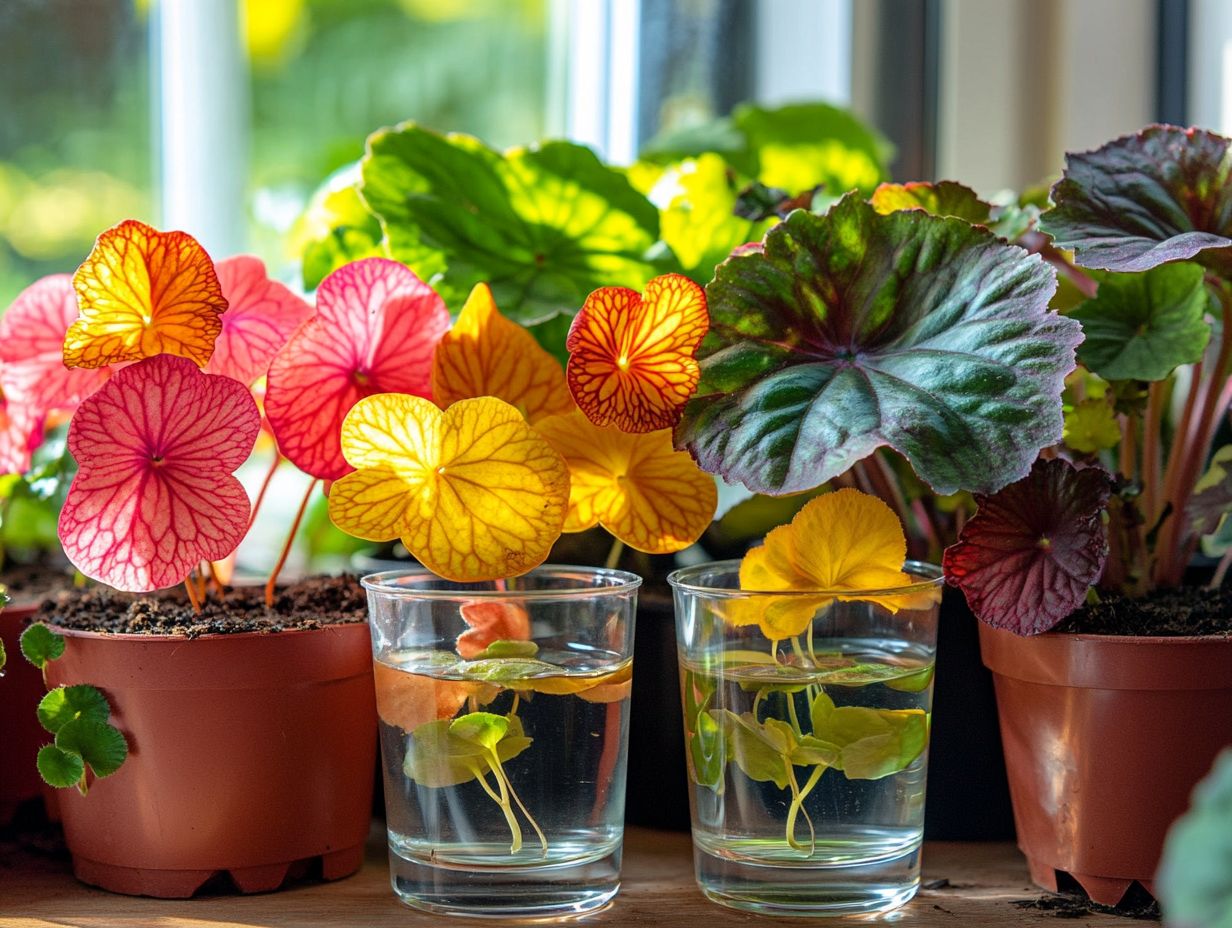
Grasping the diverse propagation techniques for begonias such as leaf cuttings, stem cuttings, and tuber cuttings is essential for any dedicated plant enthusiast. These methods enrich your home garden with flourishing, vibrant specimens.
Each method presents distinct advantages and caters to various begonia species. Pay attention to specific details to ensure optimal success.
Leaf Cuttings
Leaf cuttings are an easy way to propagate begonias. You can create new plants from just one healthy leaf!
Using rooting hormone speeds up root growth, making this technique particularly advantageous for certain begonia species known for their vibrant foliage that thrives in a moist environment.
Select healthy, undamaged leaves; the quality of your plant material is crucial for successful growth. After preparing the cuttings, place them in a warm spot with plenty of light to enhance their rooting potential.
Maintain humidity around the cuttings by using a plastic bag or a humidity dome to create the optimal atmosphere.
Check regularly on the moisture levels in the soil to prevent your cuttings from drying out, which promotes healthier roots. By following these steps, you significantly increase your chances of establishing strong, vibrant new plants.
Stem Cuttings
Stem cuttings are a great way to propagate begonias. They produce new plants that keep the same traits as the parent plant.
To ensure successful rooting, provide the right environmental conditions, including adequate humidity and well-drained potting soil.
Carefully select healthy stems from your parent plant, making sure they show no signs of disease or damage. Aim for cuttings that are about four to six inches long, with at least two or three leaf nodes.
For optimal success, place these cuttings in a moist medium, like perlite or a peat-based mix. Consider using a rooting hormone to encourage quicker root development.
Maintain a warm environment, ideally around 70 F (21 C), to promote growth. Frequent misting helps keep humidity levels high, crucial for your cuttings to thrive.
Keep a close eye on the moisture levels in the soil, ensuring it remains damp but not soggy. Soon, roots will establish, paving the way for nurturing and eventual transplanting into larger pots.
Division
Division is an effective way to propagate begonias. You can create several new plants from one mature specimen!
This method is particularly advantageous for rhizomatous begonias, where careful handling promotes healthy growth and vibrant foliage.
Timing is essential for the best results. Perform division during the plant s active growth period in spring or early summer. Use quality gardening supplies, such as sharp, sterilized tools, to minimize damage to both the parent plant and the newly separated sections.
After dividing, pot the new segments in well-draining soil and maintain a humid environment to encourage robust root development. Proper attention during this process enhances survival rates and results in more vigorous and visually striking additions to your plant collection.
Caring for Propagated Begonias

Proper care makes your propagated begonias flourish into vibrant plants.
This involves mastering the art of proper transplanting and maintenance techniques that foster healthy growth and radiant leaves.
By understanding the specific needs of each begonia species such as their ideal potting soil and humidity preferences you’ll establish a solid foundation for successful plant care and gardening advice.
Transplanting and Maintenance Tips
Transplanting your propagated begonias requires a careful touch as you move them to larger pots filled with well-drained soil. This provides their roots the space they need to grow and flourish.
Following this transition, maintaining a moist environment and ensuring adequate humidity are crucial for promoting their healthy development.
Selecting a pot with excellent drainage is essential. You should fill it with a nutrient-rich mixture that includes plenty of organic matter. Once your begonias are comfortably settled, they will thrive in bright, indirect light steering clear of direct sunlight that can scorch those delicate leaves.
Watering techniques are equally important. Water them thoroughly, but ensure the top inch of soil dries out between sessions. Apply a balanced, water-soluble fertilizer every few weeks during the growing season to encourage those vibrant blooms to burst forth. To create a humid environment, consider misting your plants or using a humidity tray.
Common Issues and Troubleshooting
Identifying common issues and troubleshooting them effectively is essential for preserving the health and vitality of your Begonias throughout their growth cycle. By remaining vigilant and attuned to the specific signs of distress, you can proactively address problems related to pests, diseases, or environmental conditions before they hinder healthy growth.
Identifying and Addressing Problems
Being vigilant for signs of distress, such as yellowing leaves, stunted growth, or pest infestations, is key to maintaining your plants’ vitality. It’s important to consider gardening tips that will help maintain these vibrant colors.
By taking a proactive stance and implementing ways to keep pests away along with organic treatments, you can ensure your Begonias thrive in a disease-free environment, making them ideal for your home garden.
Common problems include pesky aphids, spider mites, and powdery mildew, each of which can easily wreak havoc on these stunning plants. To combat aphids, consider introducing natural predators like ladybugs an effective and eco-friendly solution. For spider mites, misting the foliage regularly helps maintain humidity and discourages these unwelcome guests from settling in. If powdery mildew makes an appearance, boosting air circulation and applying a simple mixture of water and baking soda can work wonders.
By understanding these challenges and responding swiftly, you can significantly enhance the overall health of your begonias, creating a flourishing haven for these beautiful plants.
Frequently Asked Questions
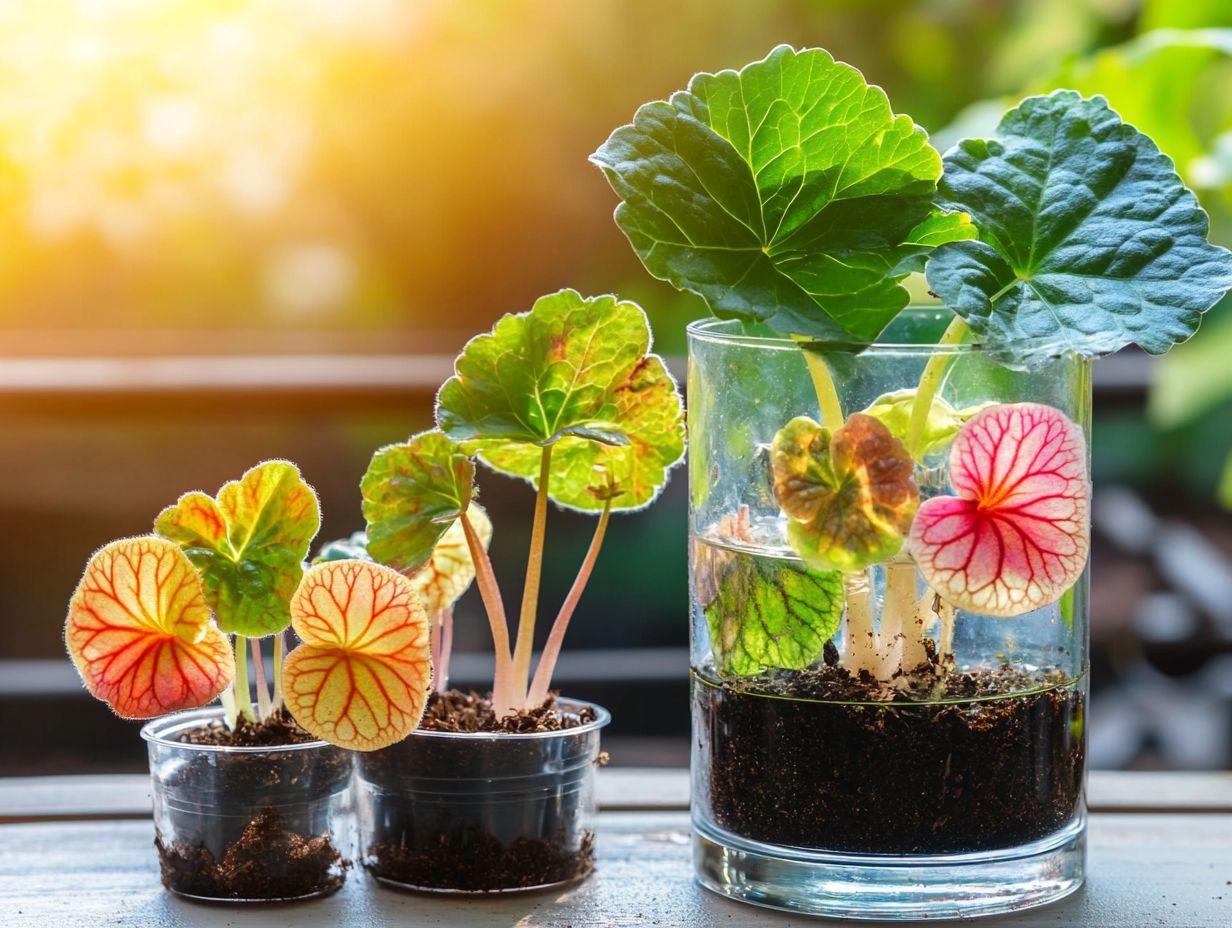
-
What is the best way to propagate Begonias?
The most successful way to propagate Begonias is through stem cuttings. This method involves taking a cutting of a healthy, mature plant and rooting it in water or soil.
-
When is the best time to propagate Begonias?
The best time to propagate Begonias is during the spring or summer months when the plant is actively growing. This will give the cutting the best chance to root and establish itself.
-
What type of soil should be used for propagating Begonias?
Begonias prefer a well-draining soil, so a mixture of potting soil and perlite or sand is recommended. This will ensure that the cutting’s roots have enough oxygen and will prevent root rot.
-
Can Begonias be propagated from seeds?
While it is possible to propagate Begonias from seeds, it is not the most reliable method. Begonia seeds can be difficult to find and can take a long time to germinate. Stem cuttings are a more efficient and successful way to propagate Begonias, especially when considering the flowering season.
-
How long does it take for Begonia cuttings to root?
On average, Begonia cuttings take about 2-3 weeks to root. However, this may vary depending on the environmental conditions and the health of the cutting. Using a substance to help roots grow can also aid in the root development of these cuttings. It is important to keep the cutting in a warm and moist environment to encourage root growth.
Start your Begonia journey today and watch your garden flourish!
What are some tips for successfully propagating Begonias?
Some tips for successful Begonia propagation include using a rooting hormone to encourage root growth and keeping the soil consistently moist but not waterlogged.
Provide the cutting with bright indirect light. Using well-drained soil mixtures, such as potting soil and perlite, enhances the propagation process.
A rooting hormone is a substance that helps plants grow roots. Avoid overhandling the cutting and give it time to establish itself before moving it to a larger pot.
Ready to grow your Begonias? Follow these simple tips to ensure your propagation is a success!

